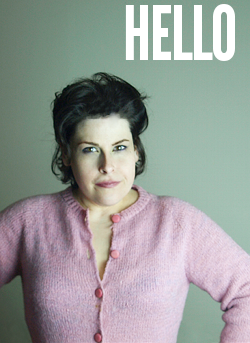Snap Your Fingers, Edith: How a Crazy Bus Driver Can Teach You All About Building an Audience Before You Have a Niche
By Jessica Albon

In the imaginary world where your business is a bus, each of the five Brand Sirens types has a different approach to bus-driver-dom. For instance, Audreys tend to have trouble leaving the station (what if someone’s just running late and really needs this bus?) and Katharines tend to leave before the assigned time (what if we miss half the fun out there because we’re lollygaging?).
(Wondering who the heck are Edith, Katharine, and Audrey? They’re three of the five Brand Sirens. Basically, they’re role models for an easier approach to stepping into the spotlight with your business. If you’d like to find out who your role model is, you can take the free quiz.)
Ediths, though, start with the bus station.
See, an Edith tends to rename the bus. She rewrites the routes. And she has a tendency to suddenly pull out of the station while someone’s still getting on (or off) the bus.
In other words, she can be a danger to herself and others! (Hold on, though–since you’re not actually driving a bus, all of this is actually a good thing, handled safely.)
See, Edith has to generate controversy. Even if it’s just a small controversy. That’s because she likes to shake things up in order to get to the truth at the core of things–she doesn’t really believe things can change until there’s been some chaos.
And she thrives on change. Inspiring it. Instigating it. Creating it. Lunging into it.
The problems of being an Edith
All of this adds up to two interesting problems. One, Ediths are the most likely to look like “overnight successes” because they’re constantly reinventing their stuff until something sticks. So, Bus Driver Edith seems to come out of nowhere because until three weeks ago, she was working very hard as a roofer.
While on the surface it looks like Edith catapulted to fame and stardom, the truth is, she’s been working really, really hard. Usually, too hard. This is partly because, if you change what you’re doing every six months, you also have to rebuild your audience. It’s also partly because Edith likes chaos and that often results in audience attrition (most people don’t like change–change too often, and even the people who really like you start to feel uneasy).
So, that’s problem number one–Ediths who are successful usually look like overnight successes leaving new Ediths, or Ediths who haven’t broken through yet, thinking they’re never going to make it.
Let’s go back to the bus driver analogy to find problem number two. Remember when I said that Edith rewrites the bus routes? Well, the problem here is that she forgets to print new maps. So, people who are there during the change usually are okay–she’s more than happy to tell people that they’re taking the Strawberry Bus Route instead of the Green Apple Bus Route. But, after a few weeks, when all the old bus riders have gotten used to the new routes, it’s all but forgotten that the routes have been rewritten.
This results in two problems. One, new people stop taking the bus. Because no one understands any of the routes but their own, they can’t recommend the bus system to any of their friends (remember, there are no maps to share). Plus, if a new person should happen to wander into the bus station, the only person who can explain what’s going on is Edith (who’s usually off driving a bus) and Ediths tend to get impatient explaining changes after the first few weeks.
So, no new people on the bus.
The other problem is that should a new person brave the whole system and find themselves on the right bus… They usually feel left out because Edith’s taught the whole bus a bus song that the new person doesn’t know, and the only way to get the bus to stop is to put one hand on your head and shout, “GO!” and wiggle your ears three times.
In other words, Edith tends to build a clique separated from other people through vocabulary, rituals, and knowledge. Which makes newcomers feel out of place and uncomfortable and unlikely to stick around.
What then is an Edith who doesn’t want to alienate people to do?
Case Study One: How not to alienate new people
Take a look at Havi Brooks. When you visit her blog, the first thing you notice is that she has a glossary at the top of the page. Yep, a glossary.
See, Edith almost always invents her own language. And her core people catch on pretty quickly and soon everyone’s using the same vocabulary which tends not to make much sense to outsiders. Which means that when someone new comes by, things feel really exclusive, and not in a good way.
But by adding a glossary (and notice how Havi goes one step further by also including definitions and links to how a particular process began in individual posts) you can help people get up to speed much more quickly, reducing the frustration they feel and the likelihood that they’ll leave before they catch on.
Case Study Two: How to build an audience without a narrow niche
As I mentioned, because Ediths tend to move very quickly and change what they’re doing often (until settling into their right work), they have trouble building an audience. That’s because they try to niche narrowly each time they press the restart button–like all the marketing gurus tell them to–which means each new venture requires a completely new audience.
For instance, the Edith who’s providing high priced personal brand coaching this week can’t market to the same people to whom she’s providing tree cutting services the next week. But, if instead, she had focused on providing supportive environments inside and out to help her people get what they want… Well, technically trimming trees and personal brand statements go hand-in-hand that way.
One Edith who’s done a great job of not getting overly niched is coach Michael Neill. In his case, he’s build an approach that allows him to continue providing spectacular transformation for his clients, without being tied to any one mode of working with them.
See, if he were following traditional advice to niche, he’d work very specifically with, for instance, exclusively divorced, male executives, aged 45-52, who have worked at their company for at least seven years.
But, instead, his niche is personal transformation. Crazy broad! And he offers mass market books, a free radio program, a weekly newsletter, programs, and one-on-one coaching, all at dramatically different price points, but all aimed at helping people get what they want. (Nothing more, and nothing less.)
So, if you’re an Edith, don’t niche yourself until you’re really, really, really ready. And, even then, it’s okay to niche yourself much more broadly than they (the marketing gurus) tell you you can. And it’s a good idea to choose a niche based on what you absolutely love and never tire of creating instead of anything overly specific that might get a wee bit boring after awhile. (And never, ever, ever over-niche yourself unless you desperately want to.)
Case Study Three: How to break through and find an audience before you know what you’re doing
As Ediths work to find their audience and finally break through once and for all, they tend to struggle more than other types. While the rest of us can usually be relatively happy making a difference for our clients, the Edith is propelled forward by an absolute imperative to make the right difference for her clients.
She feels it’s false to be doing someone else’s work, and knows so deeply that the difference she could be making is one only she can make… Which tends to make her a bit desperate to *find* that difference.
If you’re an Edith who hasn’t found your niche yet, you probably wrestle with this. And with not wanting to get started because you don’t want to flit from thing to thing, or do a tremendous amount of work only to find it wasn’t the right work.
Fortunately, there’s a middle ground. Follow the lead of coach Tia Singh and conduct experiments. There are two reasons that this works really well–one, experiments have an entry point and an exit point. Your readers can invite other people along just before you start a new experiment knowing that anyone they invite won’t feel lost and will be able to follow along. The other reason is that experiments are fun and by their nature supposed to be transient. So, by saying, “For the next 30 days, I’m going to write one thank you note each day, and I’ll post it here to share what I’m grateful for” you aren’t a flake when, on day 31, you aren’t writing thank you notes anymore. Readers enjoy playing along, and know that they aren’t committing to anything permanently, either.
When you’re an Edith, you can find it really challenging to build the right audience, so playing with possible niches/directions/audiences using experiments is a fun way to keep your options open while opening the door to more readers. (You can even take this to the next level with blog buttons, a blogroll of participants, and regular check-ins, but that’s not at all necessary.)
How an Edith can bring it all together
Ediths are astoundingly good at creating transformation and that brings with it its own challenges–it can be hard for Ediths to focus and build an audience, it can be challenging for Ediths to build a community that’s inviting of new members, and it can be hard for Ediths to get started before knowing precisely where they belong (and, of course, that’s the time we all must start–*before* we know).
If you’re an Edith, take care to learn from other Ediths. It can be frustrating to try out strategies that work so well for other types, only to have them fail spectacularly for you. Also, be aware that even if you’re not in your *right* spot just yet, you’re still making a difference for your clients, and that absolutely is valuable. Continue to experiment until you find the sweet spot where your passions, your clients’ needs, and transformation meet. And find it you will!
Not an Edith? How this applies to you, too
If you’re not an Edith, and you’re wondering if any of this applies to you, it does! In two ways. One, Ediths online are a tempting set to follow. Things just seem easier for them in many ways–their audience embraces their style (even using the vocabulary they’ve invented), they don’t have to do anything to stand apart from others, and the magic they create is often palpable.
But, if you’re not an Edith, you’ll often find that following one as a role model feels a little empty. It’s just not as rewarding as following your own path. That doesn’t mean you can’t learn from Edith–her experiments work well for all of us (just be sure to include plenty of structure and to follow through to the end) when we’re feeling a bit uncertain about what’s next (or just want to shake things up a bit and add some variety). Most of us could also stand to learn from a welcoming Edith’s approach to audience–bringing people who’ve been around for awhile in ever tighter while still being welcoming to new people.
Whether or not you’re an Edith, it always helps to remember that those marketing techniques that seem to work spectacularly for someone else aren’t one-size-fits-all. You’re not doing it wrong if it doesn’t work for you–you just need to find the techniques, habits, and approaches that are right for your personal style and use them.
If you’re not sure if you’re an Edith, make sure to take the Brand Siren quiz to discover your style.
BlogComments
Pingback: uberVU - social comments









